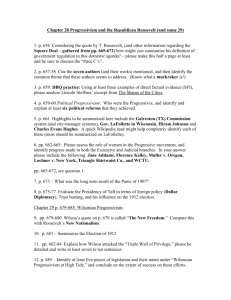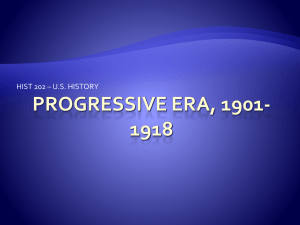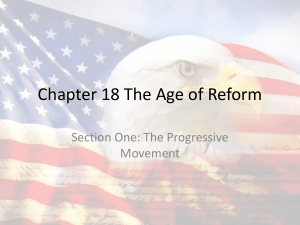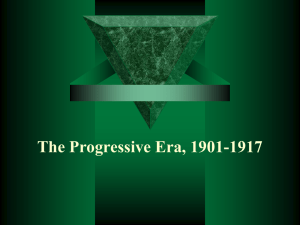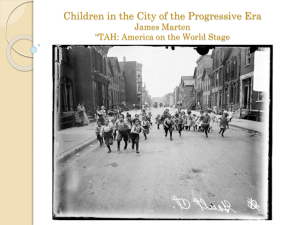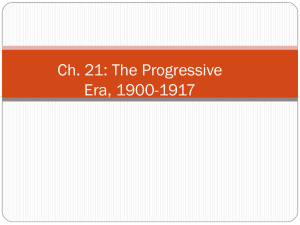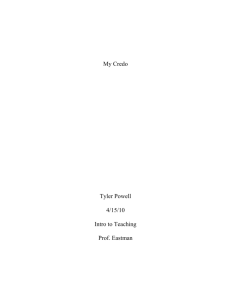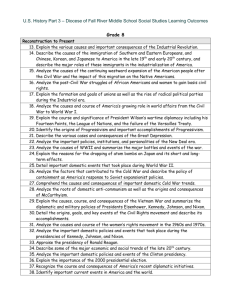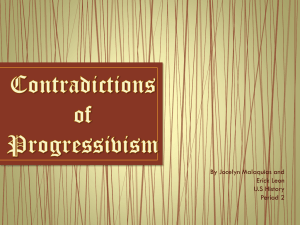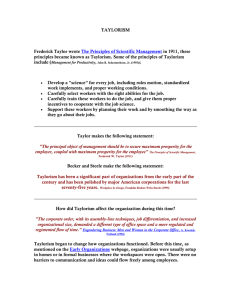Progressivism DBQ
advertisement
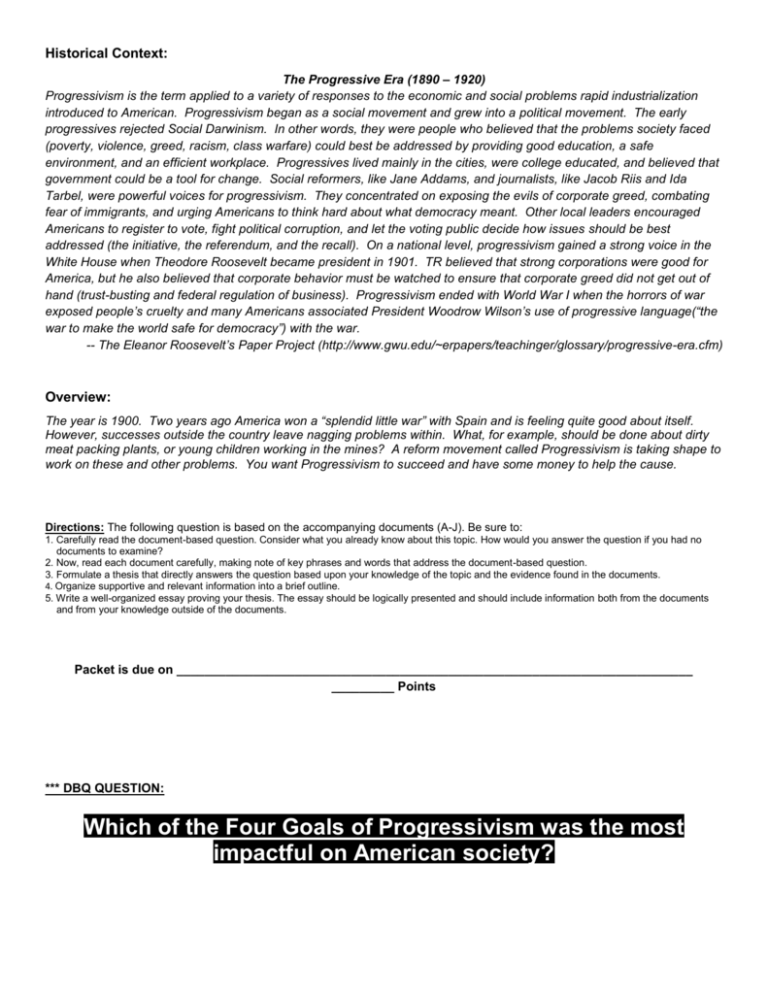
Historical Context: The Progressive Era (1890 – 1920) Progressivism is the term applied to a variety of responses to the economic and social problems rapid industrialization introduced to American. Progressivism began as a social movement and grew into a political movement. The early progressives rejected Social Darwinism. In other words, they were people who believed that the problems society faced (poverty, violence, greed, racism, class warfare) could best be addressed by providing good education, a safe environment, and an efficient workplace. Progressives lived mainly in the cities, were college educated, and believed that government could be a tool for change. Social reformers, like Jane Addams, and journalists, like Jacob Riis and Ida Tarbel, were powerful voices for progressivism. They concentrated on exposing the evils of corporate greed, combating fear of immigrants, and urging Americans to think hard about what democracy meant. Other local leaders encouraged Americans to register to vote, fight political corruption, and let the voting public decide how issues should be best addressed (the initiative, the referendum, and the recall). On a national level, progressivism gained a strong voice in the White House when Theodore Roosevelt became president in 1901. TR believed that strong corporations were good for America, but he also believed that corporate behavior must be watched to ensure that corporate greed did not get out of hand (trust-busting and federal regulation of business). Progressivism ended with World War I when the horrors of war exposed people’s cruelty and many Americans associated President Woodrow Wilson’s use of progressive language(“the war to make the world safe for democracy”) with the war. -- The Eleanor Roosevelt’s Paper Project (http://www.gwu.edu/~erpapers/teachinger/glossary/progressive-era.cfm) Overview: The year is 1900. Two years ago America won a “splendid little war” with Spain and is feeling quite good about itself. However, successes outside the country leave nagging problems within. What, for example, should be done about dirty meat packing plants, or young children working in the mines? A reform movement called Progressivism is taking shape to work on these and other problems. You want Progressivism to succeed and have some money to help the cause. Directions: The following question is based on the accompanying documents (A-J). Be sure to: 1. Carefully read the document-based question. Consider what you already know about this topic. How would you answer the question if you had no documents to examine? 2. Now, read each document carefully, making note of key phrases and words that address the document-based question. 3. Formulate a thesis that directly answers the question based upon your knowledge of the topic and the evidence found in the documents. 4. Organize supportive and relevant information into a brief outline. 5. Write a well-organized essay proving your thesis. The essay should be logically presented and should include information both from the documents and from your knowledge outside of the documents. Packet is due on __________________________________________________________________________ _________ Points *** DBQ QUESTION: Which of the Four Goals of Progressivism was the most impactful on American society? Background Essay On January 1, 1900, the United States had reason for optimism. Cities were bustling. Industry was booming. One factory owner, Andrew Carnegie, was about to sell his steel company and become the richest man in the world. Not bad for a weaver’s son from Scotland. And if Carnegie could make it, why not anyone! With victory in the Spanish-American war just behind, and a fresh new century lying before, it was a good time to be an American. However, if you peeled back the excitement and looked carefully, there was an underside. Not everyone in America was making it. In fact, in the absence of clear rules, not everyone in America had a chance of making it. Consider this: 1. Average earnings for American workers was less than $500 a year. In the South, the average for unskilled workers was closer to $300. And this was at a time when the poverty line for a family of six was $600. 2. Hours were long. In 1900, the average work week was 60 hours. In the garment industry of New York City it was 70 hours. 3. Child labor was widespread. In 1900, 26% of boys between ten and fifteen years old were in the work force. For young girls the figure was 10%. Added to this, more than half of adult Americans were denied the right to vote. Women had never had the right, and most black men had lost the vote in the years after Reconstruction. Clearly, America had some work to do. Fortunately, some people spoke out. A group of writers known as muckrakers looked into the problems and voiced their concerns. Ministers, professors, social workers, and many elected officials listened and joined in. A movement developed that was called Progressivism. The reform effort included both major political parties. It lasted about twenty years and influenced the thinking of three presidents – Teddy Roosevelt, William Howard Taft, and Woodrow Wilson. To be sure, Progressivism had its limits. For example, almost nothing was done to rid the nation of racial segregation, and labor unions were given little encouragement. However, there were other areas where important reforms were made. 1. When was the Progressive Period? __________________________________________________________________________________________ 2. What was the poverty level in dollars for a family of six in 1900? __________________________________________________________________________________________ 3. What was the average earnings of an American worker in 1900? __________________________________________________________________________________________ 4. What three Presidents served during the Progressive Period? __________________________________________________________________________________________ __________________________________________________________________________________________ __________________________________________________________________________________________ 5. What were two areas where Progressivism made little or no change? __________________________________________________________________________________________ __________________________________________________________________________________________ __________________________________________________________________________________________ __________________________________________________________________________________________ __________________________________________________________________________________________ 6. Define each of the following: underside ___________________________________________________________________________ ___________________________________________________________________________ ___________________________________________________________________________ muckraker ___________________________________________________________________________ ___________________________________________________________________________ ___________________________________________________________________________ Progressivism ________________________________________________________________________ ________________________________________________________________________ ________________________________________________________________________ Document A Theodore Roosevelt (Washington Post, 1907) 1. Who is the man in the cartoon? ___________________________________________________________________________ 2. Why is he represented in this way (hunting, his attire)? __________________________________________________________________________________________ ____________________________________________________________ 3. What is he doing? __________________________________________________________________________________________ ____________________________________________________________ 4. What do the bears represent? __________________________________________________________________________________________ ____________________________________________________________ 5. What has the man done with the bears? What does this represent? ___________________________________________________________________________ ___________________________________________________________________________ Document B This is a Senate of monopolists by the monopolists and for the monopolists! Entrance for Monopolists People’s Entrance Closed The Bosses of the Senate (Joseph J. Keppler, Puck, 1889 adapted) 1. What are two political problems identified by Joseph J. Keppler in this cartoon? __________________________________________________________________________________________ __________________________________________________________________________________________ 2. What is / are the specific meanings of the objects? __________________________________________________________________________________________ __________________________________________________________________________________________ 3. What is the main idea that the illustrator / author is trying to get across? __________________________________________________________________________________________ __________________________________________________________________________________________ Document C The Senate of the United States shall be composed of two Senators from each State, elected by the people thereof, for six years; and each Senator shall have one vote. The electors in each State shall have the qualifications requisite for electors of the most numerous branch of the State legislatures…. -- 17th Amendment, Section 1, 1913 1. State two ways the 17th amendment addressed the concern expressed in the political cartoon (Document B). __________________________________________________________________________________________ __________________________________________________________________________________________ __________________________________________________________________________________________ Document D People’s Party [Populist] Platform (Omaha Platform) July 4, 1892 …The conditions which surround us best justify our co-operation; we meet in the midst of a nation brought to the verge of moral, political, and material ruin. Corruption dominates the ballot-box, the Legislatures, the Congress and touches even the ermine [robes] of the bench. The people are demoralized; most of the States have been compelled to isolate the voters at the polling places to prevent universal intimidation and bribery. The newspapers are largely subsidized or muzzled, public opinion silenced; business prostrated [crushed], homes covered with mortgages, labor impoverished, and the land concentrating in the hands of the capitalists. The urban workmen are denied the right to organize for selfprotection, imported pauperized labor beats down their wages, a hireling standing army, unrecognized by our laws, is established to shoot them down, and they are rapidly degenerating into European conditions. The fruits of the toil of millions are boldly stolen to build up the fortunes for a few, unprecedented in the history of mankind; and the possessors of these turns, in turn, despise the Republic and endanger liberty. From the same prolific womb of governmental injustice we breed the two great classes – tramps and millionaires… -- National Economist, Washington, D.C., 1892 1. According to this political party platform, what were five specific problems that led to the foundation of the Populist Party? __________________________________________________________________________________________ __________________________________________________________________________________________ __________________________________________________________________________________________ __________________________________________________________________________________________ __________________________________________________________________________________________ __________________________________________________________________________________________ __________________________________________________________________________________________ __________________________________________________________________________________________ __________________________________________________________________________________________ Document E The boys working in the breaker are bent double, with little chance to relax; the air at times is dense with coal-dust, which penetrates so far into the passages of the lungs that for long periods after the boy leaves the breaker, he continues to cough up the black coal dust. Fingers are calloused and cut by the coal and slate, the noise and monotony are deadening…While I was in the region, two breaker boys of 15 years…fell or were carried by the coal down into the car below. One was badly burned and the other smothered to death. This was the Lee Breaker at Chauncy, Pennsylvania, January 6th, 1911. The boy who as killed was Dennis McKee. -- Lewis Hine, National Child Labor Committee Report, 1911 Note: Breaker boys were located just outside the mine next to a machine (called a breaker) where they sorted and separated the coal from slate rock. 1. What was a breaker boy? __________________________________________________________________________________________ __________________________________________________________________________________________ 2. How old were the two boys who were injured and killed at the Lee Breaker? __________________________________________________________________________________________ __________________________________________________________________________________________ 3. What is the main idea of the Lewis Hine report? __________________________________________________________________________________________ __________________________________________________________________________________________ __________________________________________________________________________________________ 4. How does the photograph help support the report’s descriptions? __________________________________________________________________________________________ __________________________________________________________________________________________ __________________________________________________________________________________________ __________________________________________________________________________________________ __________________________________________________________________________________________ __________________________________________________________________________________________ __________________________________________________________________________________________ __________________________________________________________________________________________ Document F …Be a little careful, please. The hall is dark and you might stumble over the children pitching pennies back there. Not that it would hurt them: kicks and cuffs are their daily diet. They have little else…All the fresh air enters these stairs is from the hall-door that is forever slamming…Here is a door. Listen! That short, hacking cough, that tiny helpless wail – what do they mean?...The child is dying with measles. With half a chance it might have lived: but it had none. That dark, bedroom killed it… -- Jacob Riis, How the Other Half Lives, Charles Scribner’s Sons, 1890 1. State two problems faced by cities in the United States in the late 1800s. __________________________________________________________________________________________ __________________________________________________________________________________________ __________________________________________________________________________________________ __________________________________________________________________________________________ 2. Identify one reform that was proposed by Progressives to improve this situation. __________________________________________________________________________________________ __________________________________________________________________________________________ Document G …the manufacture, sale, or transportation of intoxicating liquors within, the importation thereof into, or the exportation thereof from the United States and all territory subject to the jurisdiction thereof for beverage purposes is hereby prohibited. -- United States Constitution, 18th Amendment, Section 1, 1919 “Wet” and “Dry” Map of the United States – January 1904 “Wet” and “Dry” Map of the United States – March 1917 1. State two ways reformers tried to stop the sale of intoxicating liquors in the United States. __________________________________________________________________________________________ __________________________________________________________________________________________ 2. Analyze the two maps. What can be concluded regarding prohibition? __________________________________________________________________________________________ __________________________________________________________________________________________ __________________________________________________________________________________________ Document H A woman’s simplest duty…is to keep her house clean and wholesome and to feed her children properly. Yet if she lives in a tenement house, as so many of my neighbors do, she cannot fulfill these simple obligations by her own efforts because she is utterly dependent upon the city administration for the conditions which (make) decent living possible. Her basement will not be dry, her stairways will not be fireproof…She cannot even secure untainted meat for her household…unless the meat has been inspected by city officials… …(If) women would fulfill her traditional responsibility to her own children…then she must bring herself to use the ballot…American women need this…to preserve the home. -- Jane Addams, “Why Women Should Vote,” Ladies Home Journal, January, 1910 Note: Jane Addams was the co-founder in 1889 of Hull House, a famous settlement house in Chicago. 1. What is “the ballot”? __________________________________________________________________________________________ __________________________________________________________________________________________ 2. Why does Jane Addams say that it is necessary for women to get the ballot? __________________________________________________________________________________________ __________________________________________________________________________________________ __________________________________________________________________________________________ __________________________________________________________________________________________ __________________________________________________________________________________________ 3. In the photo the sign being displayed reads, “Mr. President, How Long Must Women Wait For Liberty?” The protesters were standing in front of the White House. Was this a good way for women to fight for the vote? Why or why not? __________________________________________________________________________________________ __________________________________________________________________________________________ __________________________________________________________________________________________ __________________________________________________________________________________________ __________________________________________________________________________________________ __________________________________________________________________________________________ __________________________________________________________________________________________ __________________________________________________________________________________________ __________________________________________________________________________________________ __________________________________________________________________________________________ __________________________________________________________________________________________ __________________________________________________________________________________________ Document I There was never the least attention paid to what was cut up for the sausage…there would be meat that had tumbled out on the floor, in the dirt and sawdust, where the workers had tramped and spit…There would be meat stored in great piles in rooms; and the water from leaky roofs would drip over it, and thousands of rats would race upon it. It was too dark in these storage places to see well, but a man could run his hand over these piles of meat and sweep off handfuls of the dried dung of rats. These rats were nuisances, and the packers would put poisoned bread out for them; they would die, and then rats, bread and meat would go into the hoppers together. This was no fairy story and no joke; the meat would be shoveled into carts and the man who did the shoveling would not trouble to lift out a rat even if he saw one… -- Upton Sinclair, The Jungle, Viking Press, 1905 Note: The Jungle was a novel that described the conditions in the Chicago meat-packing industry. 1. What detail from Upton Sinclair’s book is the most disgusting to you? __________________________________________________________________________________________ __________________________________________________________________________________________ __________________________________________________________________________________________ __________________________________________________________________________________________ __________________________________________________________________________________________ 2. If you were alive in 1906, and had just read this book, what might you decide to do to change the situation? __________________________________________________________________________________________ __________________________________________________________________________________________ __________________________________________________________________________________________ __________________________________________________________________________________________ __________________________________________________________________________________________ __________________________________________________________________________________________ __________________________________________________________________________________________ 3. How does the photo support Sinclair’s claims about the meat-packing industry? __________________________________________________________________________________________ __________________________________________________________________________________________ __________________________________________________________________________________________ __________________________________________________________________________________________ __________________________________________________________________________________________ __________________________________________________________________________________________ __________________________________________________________________________________________ Document J Fostering efficiency was based around the idea of making society and the workplace more efficient. According to the Brandeis brief, long work hours was costing both individuals and society. With this idea Frederick Winslow Taylor introduced the idea of “Taylorism”. Taylorism is a type of scientific management where efficiency is improved by breaking down tasks into simpler parts. Taylorism increased the rate of production greatly. Also workers were interchangeable. Skilled workers were no longer relied on because any unskilled worker could complete the simple task at hand. Many industries started using Taylorism. Though this system sped up production it also required people to work extremely fast. Workers were exhausted quickly. Henry Ford kept his workers happy by making the work day only eight hours and paid five dollars a day. Workers flocked to these changes, but worked hard for them. Fostering efficiency brought many changes in the progressive era. The workplace before these changes was long hours, with complicated task only skilled workers could complete. After Taylorism was introduced production sped up, the work day was shorter, and unskilled workers completed simple tasks. -- http://progressiveeraexhibition.weebly.com/fostering-efficiency.html 1. What was the purpose of fostering efficiency? __________________________________________________________________________________________ __________________________________________________________________________________________ __________________________________________________________________________________________ __________________________________________________________________________________________ __________________________________________________________________________________________ 2. Define Taylorism. __________________________________________________________________________________________ __________________________________________________________________________________________ __________________________________________________________________________________________ 3. How does the photograph promote fostering efficiency? __________________________________________________________________________________________ __________________________________________________________________________________________ __________________________________________________________________________________________ __________________________________________________________________________________________ __________________________________________________________________________________________ __________________________________________________________________________________________ __________________________________________________________________________________________ __________________________________________________________________________________________ __________________________________________________________________________________________
